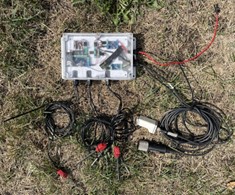By Ann Piotrowski, University of Minnesota
As part of the WinterTurf project, golf courses hosted sensing nodes to collect environmental data on their greens during the winter season. Here at GEMS Sensing, we’re preparing for next year’s WinterTurf deployment.

During the 2022 - 2023 WinterTurf season, we deployed 62 nodes across the northern US and Europe. Our current fleet has two sensor configurations. WinterTurf Type A includes three soil moisture and temperature sensors, one CO2 sensor, and one O2 sensor. WinterTurf Type B includes two CO2 sensors and two O2 sensors. Duplication of these sensors allows us to observe the readings across different depths. Our fleet also includes two different versions of data loggers, the v2 version (Figure 1) and the updated v3 version (Figure 2).

This upcoming season our goal is to deploy 85 nodes across the US and Europe, increasing the number of v3s in the fleet. These nodes capture data at 15-minute intervals and can be viewed in real-time via our user interface hosted on Grafana (Figure 3).

To prepare for the 2023-2024 WinterTurf season the superintendents shipped back the majority of nodes for cleanup and general maintenance. The workflow to get the equipment prepped for the next field season includes cleaning, downloading onboard data backup, replacing the desiccant packets, and inspecting the nodes for damage. We make any repairs necessary such as fixing nicked cables, replacing sensors, charging batteries, and updating firmware. Our biggest improvement for this year is increased battery life. By updating the firmware we can sustain the data logger for up to a month with little to no solar input.
Before shipping out, we do a final quality check. This entails turning the data logger on, checking cellular connectivity, and confirming the sensors are reading within range. As we wrap up prep, I find that while I’m not looking forward to winter, I am looking forward to another successful WinterTurf deployment.